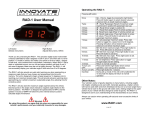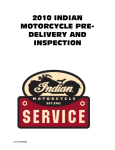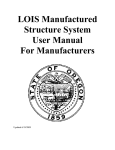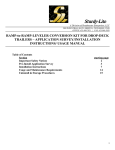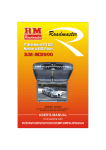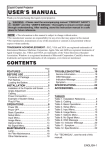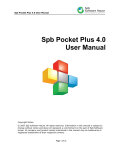Download Owner`s Manual Bicycle Sidecar For 17 Year Old (CP) Date: 4
Transcript
Owner’s Manual Bicycle Sidecar For 17 Year Old (CP) Date: 4/29/11 Team #12 Team Members: Michael Wieczerzak Nicholas Ouellette Elida Babollah Client: Scott, Julie and Abby Miller [email protected] Table of Contents 1. Important Safety Instructions (Page 2) 2. Parts and Accessories (Page 3) 3. Features (Page 9) 4. Introduction 4.1 Overview 4.2 Step-by-Step Instructions 4.2.1 Overview of the Instructions 4.2.2 Pictures of the Step-By-Step Instructions (Page 10) (Page 10) (Page 13) (Page 13) (Page 14) 5. Maintenance 5.1 Inner Fender 5.2 Outer Fender 5.3 Leg-rests 5.4 Foot-rests 5.5 Foot-straps 5.6 Seat 5.7 Frame 5.8 Hitch Attachment 5.9 Tires 5.10 Tire Axels (Page 20) (Page 20) (Page 20) (Page 21) (Page 21) (Page 21) (Page 21) (Page 21) (Page 21) (Page 22) (Page 22) 6. Technical Description 6.1 Bicycle Sidecar 6.2 Hitch Attachment 6.3 Copper Ring Clamps 6.4 Sidecar Frame 6.5 Sidecar Tires 6.6 Carrie Tumbleform Seat 6.7 Fenders 6.8 Leg Supports (Page 22) (Page 22) (Page 23) (Page 24) (Page 24) (Page 25) (Page 26) (Page 27) (Page 28) 7. Troubleshooting 7.1 Overview 7.2 Attachment to Bike 7.3 “O” Rings 7.4 Attachment Rods 7.5 Straps 7.6 Tires 7.7 Fenders 7.8 Non-Slip Material (Page 28) (Page 28) (Page 29) (Page 30) (Page 32) (Page 33) (Page 34) (Page 37) (Page 38) 1 1. Important Safety Instructions When using the bicycle sidecar some precautions must be taken into consideration to ensure that both the rider of the bike and sidecar are not injured. The best way to use and operate the sidecar is to first secure the sidecar to the bicycle. This will not only make the sidecar secured and no wobbly, but it will be much easier to attach the rings to the frame. Once the sidecar is attached the rider may enter. The outside fender is on a hinge mechanism, which will make it easier to assist any riders that may need help to get in. The footrests swing out so that it does not interfere with someone trying to sit in the seat. Once the person has sat in the Tumbleform seat. Adjust any of the straps so that it fits the rider the way it is meant to and that they are securely against their chest. Also move the neck support so that it is resting behind their neck for full support. Once the rider is securely in the sidecar make sure that the outside fender is back in the riding position and locked into place. To make sure that both the rider in the sidecar and the bike are safe please use a helmet at all times while using the device. The most important safety measure that must be done before the operation of the sidecar is to strap the rider in using the safety straps that have been installed in it. There are two major straps one for the upper body and then a pair for each foot that secures them to the footrest. The strap for the upper body is critical because this secures the rider to the seat and does not allow them to move around putting them or the bike rider in danger. The straps that are connected to the footrests are extremely important because they make sure that the feet of the rider do not get caught under the sidecar as it moves. Make sure that both of the straps are secured around the foot of the rider. Also, adjust the footrest to angle that is most comfortable for the rider. The footrests have been designed so that the lowest position will not touch the ground while riding on normal conditions. When riding in the bicycle sidecar make sure that all connections are safely secured and that nothing seems to loose. Since the bike is connected to the sidecar in three places all of those points need to be checked. The screws on the rings that connect to the bikes frame use both Philips and flathead screw drivers. It has been tested many times and the group has recommended that the flathead works best to get the screws secured. Make sure that the rings are flush with frame and then tighten the screws until it cannot be turned any more. Make sure that the rod that connects to the sidecar is securely in the slots. This should not be an issue at anytime, but checking them will reduce any chance of a problem. When using the sidecar make sure that the area that is being used to ride is very open and that there is plenty of room for both the sidecar and the bike. This is essential because if one of the components goes off the path/road it will be very hard and dangerous to ride unless they are stopped. The best place to use the bicycle sidecar is an empty parking lot or a very open area. 2 2. Parts and Accessories In this section all of the parts of the sidecar will be shown with an actual picture from the device. This will allow for better understanding of the rest of the Owner’s Manual. Figure 1: Frame of the sidecar. Figure 2: Hinge mechanism for the outside fender. 3 Figure 3: Neoprene padding on the fender. Figure 4: Fenders for the sides of the sidecar. 4 Figure 5: Hitch attachment system for the sidecar. Figure 6: Tires for the sidecar. 5 Figure 7: Seat that is attached to the sidecar. Figure 8: Bike purchased for the sidecar. 6 Figure 9: Footrests used for the sidecar. Figure 10: Non-slip material that was added to the seat. 7 Figure 11: Footrest with straps attached to the footrests. Figure 12: Pin to secure the outside fender. 8 3. Features Since this sidecar was a custom made device there are many personal features that make it very individual. Some of the features include the ability to swing the outside fender for easy access to the seat, moveable footrests which make it much easier to get in and the attachments have the capability of being able to attack to a 26-inch bike. This is a very unique sidecar, which can allow may people to enjoy a great bike ride experience. The first feature that needs to be described is the opening and closing of the outside fender. This was a requested feature that would make getting someone in and out of the sidecar from the side. Since lifting and placing someone from just facing forward can be difficult this adds another angle, which could allow a second person to help. The fender is attached to a hinge that allows it to move backwards and revels the entire outside portion of the sidecar. It locks into place on the frame of the sidecar using a pin locking mechanism. This ensures that the fender, when in the down and riding position, is safe for the rider and will not injure them. This feature is very easy to use and is encouraged to do so. It was designed to be very simple and time efficient, allowing the riders to get to the bike ride quicker. The next big feature about this sidecar is that the footrests and the calf pads are moveable. This makes it incredibly easy to help someone into the seat and make him or her comfortable without having to deal with them in the way. The footrests swing up and then the calf pads move towards the outside of the frame giving a clear entrance into the sidecar. To ensure that the calf pads to not get ripped the user must make sure that the footrests are out enough that the screw on the bottom does not rub up against the padding. Another feature of the footrests is that they are adjustable to the rider’s need. They can move form their downward position (almost 90 degrees) to almost parallel to the ground. This will let the rider pick the most enjoyable position for their legs yet keep them completely safe while doing so. Another great feature of this sidecar is that it can adapt to almost any 26-inch bike. Although this may be a little difficult to make sure that it matches up correctly and safely, the sidecar has the ability to do so. Three bars that are connected with nuts to the attachment bars so it can be moved to how the rider would like it attach the sidecar. By pulling certain rods closer and farther apart it will allow for the bike to make it easier to turn depending on the make and model of the bike. This feature is very unique because it allows for the use of many bikes depending on the bike riders preference. Finally, the ability to adjust the seat and all of its attributes to the rider is very unique. The Carrie Tumbleform seat is specifically designed to support the rider while making it comfortable at the same time. The seat comes with a Velcro neck support so if the rider grows or wants to sit in another position it is not a problem and easily adjustable. Also, the straps and harnesses are adjustable and very easy to secure the rider in place. Overall, this sidecar has many useful features that will make it a very enjoyable, yet pleasant experience when using it. 9 4. Introduction 4.1 Overview This sidecar was custom designed for Abby Miller and was tailored to her dimensions. The basic design of the sidecar is focused around the frame. The frame is essentially a large square with two wheel wells and then supports and attachment points were added to it. The rest of the parts to the sidecar then are attached to the aluminum frame. Along with the frame some other keys pieces to the sidecar include the Tumbleform seat, the fenders, leg rests, tires and the attachment bars to the bike. The Tumbleform seat was essential to this project because it needed to be completely supportive of Abby yet safe and stable enough for the moving sidecar. The fenders were designed in a way so to not only protect Abby form the spinning wheels but also has a protective layer of neoprene padding so ensure Abby would not get hurt is bumping up against it. The leg rests have the ability to fold outward which makes getting into the sidecar very easy for the rider. Also, they have the ability to tilt them at the angle that is more desired by the passenger. The attachment bars are critical in holding the sidecar to the bike. They are very secure and allow for a smooth ride. To see these parts of the sidecar please refer to the parts section of the user manual. Essentially there are only a few steps to make the sidecar functional and ready to ride. The first step is to align the sidecar up with the bike. Then make sure that the clamps (“o” rings) are in position to secure. Once all three of the “o” rings are in place the easiest way to secure it is by screwing in the clamp that is on the bottom horizontal bar first. Then screw in the other clamp that connects to the back. The front clamp should be last and should not have any trouble securing if the other two were placed in the correct positions. Once the bike is secured to the sidecar it is ready for use and all that is left is having the passenger sit in the seat and strap in. Below are a few pictures illustrating what was just described. Figure 13: Aligning the sidecar with the bike. 10 Figure 14: Where the back clamp is located on the horizontal bar on bike frame. Figure 15: Where the back clamp is located on the angled bar on the bike frame. 11 Figure 16: Where the front clamp is located on the bike frame. Figure 17: How the sidecar/bike setup should look after attachment. 12 4.2 Step-By-Step Instructions 4.2.1 Overview of Instructions The use of this product is relatively simple as long as the attachment to the bike is done properly. In this section of the owner’s manual, a step-by-step description of how to attach the bike to the sidecar and then ride in a safe manner. While attaching the sidecar to the bike no one should be in the sidecar to ensure that no one gets hurt. This also allows the sidecar to be maneuvered easier to get in to the position that is needed to attach it. In the next few paragraphs an overview of the step up procedure will be talked about. In the following section of this manual, a step-by-step picture diagram will be used to help illustrate the words. When beginning to set up the sidecar make sure that the connection rod are in the correct positions in the holder on the sidecar. Although the sidecar can be attacked to any 26” tire bike with careful adjustment, this manual will describe the attachment to the bike that was provided for the family. The best way to align the sidecar attachment to the bike in the correct positions will be to place wooden blocks under the corners of the aluminum frame to stabilize the sidecar form wobbling. Once the sidecar is stable, move the bike to position that aligned the “o” rings to the designated area on the bike’s frame. Like mentioned before in the previous section the best way to attach the bike to the sidecar starts attaching the ring that attaches to the back horizontal bar. The next step would be to attach the “o” ring to the angled bar on the back as well. Finally, the last part to attach the sidecar to the bike would be to secure the ring that attaches under the handle bar. Once the bike is secured into position, the bike rider should take the empty sidecar for a short ride to ensure that nothing is lose and that everything feels right. Once the bike and the sidecar are ready for a passenger, unlock the pins on the outside fender. Swing the fender up and behind the sidecar. This will allow for the rider to assist the passenger from the side into the seat. Once the passenger is in the seat adjust the angle of the footrests so that they are comfortable. The next step is to strap both their feet into the footrests and then secure their body with the chest straps. Ensure that the neck support is in the correct position to completely support and keep the rider safe. Once the sidecar passenger is secure it is time to start riding. There are some safety precautions that need to be taken while riding in the sidecar. The sidecar and the bike combination were not designed for fast or aggressive riding, but a leisure ride around a wide-open, flat area. This is critical because to ensure that there is not unnecessary force on the attachment points a slower speed is essential. Also, a flat area is key to a successful ride because it will allow the least amount of energy for the rider to get the sidecar going and for stopping purposes. Also, while riding the sidecar, make sure that they turns are wide and not very sharp. Keep in mind that the sidecar with a rider is heavy and that sharp turns will put a lot of force on the attachment points and you could run the risk of breaking them. Overall, as long as the bike ride stays in control of their speed and makes smart choices about turning there should absolutely be no problem or risk of breaking the attachments. 13 4.2.2 Pictures of the Step-By-Step Instructions Figure 18: Placing the wood blocks under the frame to stabilize it. Figure 19: Ensuring that the attachment rods are in the correct position in the holders. 14 Figure 20: Aligning of the bike to the sidecar’s attachment points. Figure 21: Attaching the first “o” ring. 15 Figure 22: Attaching the second “o” ring. Figure 23: Attachment of the final “o” ring. 16 Figure 24: Removal of the pins on the outside fender. Figure 25: Opening of the outside fender. 17 Figure 26: Open position of the outside fender. Figure 27: Adjusting the footrests. 18 Figure 28: Straps for the footrest. Figure 29 Straps for the upper body. 19 Figure 30: Moveable neck support. 5. Maintenance 5.1 Inner Fender Make sure all of the bolts holding the fender to the frame are tightened. Check the weld points to make sure that they aren’t loose. If they are, do not use the sidecar until they are properly re-welded by a professional. Check the adhesion of the neoprene padding to make sure that it is still properly attached to the fender. 5.2 Outer Fender Check that the screws on the hinge are tightly attached to the frame. Check that the neoprene padding is still properly attached to the fender and that the weld points on the fender are not loose or broken. If they are, do not use the sidecar until they are properly re-welded by a professional. Check the lock mechanisms to ensure that they are properly fastened to the fender and that the fender is properly fastened to the frame before using the device. 20 5.3 Leg-rests Make sure that the leg-rests are properly attached to the frame. Check the screws on the frame base to ensure that they are tightened. 5.4 Foot-rests Check the footrests to make sure they are properly attached to the leg rests. Make sure that all the screws are tight and that the footrests are on straight. 5.5 Foot-straps Check the foot straps to make sure that the Velcro material is not worn out or torn. If this is the case, replace the Velcro material before using the sidecar to ensure Abby’s safety. 5.6 Seat Make sure that the seat is secure to the frame before helping Abby into it. Tighten all bolts on the seat regularly. Check the weld points for the back support of the seat to make sure that they haven’t become loosened. If they have, do not use the sidecar until they are properly re-welded by a professional. Non-slip material on the seat may need to be replaced after a while. Make sure that the material is properly adhered to the seat before use. Check the chest strap to ensure that the Velcro material is working properly so that Abby can be properly secured into the seat. Check the seat belt for any wear or tear. 5.7 Frame Before the use of the sidecar, make sure that all of the weld points are still properly attached and haven’t come loose. If any of the weld points are loose or broken, do not use the sidecar until they are properly re-welded by a professional. Make sure that the seat, the tires, the fenders, the leg-rests, and the hitch attachment are all properly attached to the frame. Tighten all of the bolts and screws before use. 5.8 Hitch Attachment To ensure effective hitch attachment, check the weld points that attach the metal pieces onto the frame to make sure that they haven’t been loosened. If they have, do not use the sidecar until they are properly re-welded by a professional. Check the bolts that are holding the metal rods into the metal pieces that are attached to the frame. Make sure the bolts are tightened. Also check the clamps on the ends of the rods. Make sure that the screws on the clamps are properly fastened around the respective parts of the bike. 21 5.9 Tires Check the tires routinely to make sure that they aren’t flat or worn. If you encounter a problem with the tires, they should be replaced. When replacing a tire make sure that it is fastened securely into the frame before riding again. Make sure that the proper lubrication is used for the inside of the tires to ensure proper rotation on the axel. 5.10 Tire Axels Make sure that the bolts on the tire axels are tightened regularly so that they don’t come loose. Check the axial itself to make sure that it isn’t worn-down or broken. If this is the case, replace the tire axels before using the sidecar. 6. Technical Description 6.1 Bicycle Sidecar Figure 31: Picture of the overall bike and sidecar. 22 The bicycle sidecar is designed for comfort, safety, and enjoyment. The overall width of the device from the sidecar to the bicycle is 57 ¾ ‘’. The overall length of the bicycle is 65 ½ ‘’ The bicycle is a Roadmaster Mountain Sport with 18 speeds and 26’’ tires. The main frame length from the pedals to the front hitch attachment is 20’’ The device has the ability to turn both left and right, with the bike having a slight tilt to the right to allow for ease in turning. 6.2 Hitch Attachment Figure 32: The attachment rods to the sidecar. The hitch attachments are used to connect the sidecar to the bicycle. The bars are 5/8 ‘’ solid steel rods. These rods are connected to 6061-T6 aluminum square tubing that is welded to the frame of the sidecar as seen in the picture below. Adjustments to the length of the metal rods can be made for use with other bicycles 23 other than the Roadmaster Mountain Sport. The total length of the 2 smaller solid rods are 18’’ and the length of the largest solid rod is 26 ½ ‘’ For the three aluminum square tubes, the smallest one is 3 ¼ ‘’ long. The second square tube is 6 ¼ ‘’ long and the longest is 15 ½ “ 6.3 Copper Ring Clamps Figure 33: The copper ring clamps to attach the sidecar to the bike The copper rings were used for the hitch attachments to connect the sidecar to the bicycle frame. Two different sizes were used. The two back hitch attachments use ¼’’ diameter clamps and the front attachment uses a ½’’ diameter clamp. The clamp design allows for it to achieve the desired tightness around the frame by tightening the two screws on the outside of the clamp. 6.4 Sidecar Frame Figure 34: The aluminum frame of the sidecar. 24 The sidecar frame is constructed of 6061-T6 aluminum square tubing. The frames overall dimensions are 38 ¼’’ x 27’’. The wheel wells are 9’’ wide in order to properly hold the tire. The height of the frame from the ground to the top of the aluminum bars is 11 ¾’’. The frame is welded together and holds are parts securely in place. 6.5 Sidecar Tires Figure 35: The tires for the sidecar. For the sidecar tires, a small 20’’ kids bicycle was bought. The tires were removed from the bike and then fabricated to the sidecar. The axels used were 3/8’’ threaded steel rods which were cut to properly fit the sidecar wheel housing. A new wheel bearing was replaced with an older one in the tire seen above. New ball bearings were added and greased to the above tire as well. 25 6.6 Carrie Tumbleform Seat Figure 36: Carrie Tumbleform Seat. The Carrie Tumbleform Seat is one of the most important parts to the bicycle sidecar design. The dimensions and provided limitations to the seat are as follows. The length of the back of the seat is 32’’. The thigh depth is 18’’. The hip width allowance is 12-15’’. The height allowance for a person using the seat is 58-68’’. The weight allowance of the chair is 60-130 lbs. The neck piece is adjustable and can move on the velcro in between 17’’ and 25’’ from the bottom of the seat. The chair is fabricated to the frame at 4 different points of attachment. Two of these attachments are fabricated by steel L-brackets that are bolted to the frame. The chair is placed in between the L-brackets and is screwed in securely. The other two points of attachment are at the seat attachment bars on the back of the frame. The seat attachment bars are 14 ¼’’ each and are welded to the bottom of the frame. Screws are used to hold the back of the seat in its correct position. White non-slip mesh material was added to the seat to allow for the client to not slip out of position when riding in the sidecar. 26 6.7 Fenders Figure 37: Both the inside and the outside fenders. The fenders for the bicycle sidecar are made from .125’’ aluminum sheet metal. The metal was too thick for bending so the desired cuts were made and the pieces were welded together. The dimensions of the fenders are as follows. 12’’ 8 ¾’’ 6 7/8’’ 1 ¾’’ Figure 38: Diagram of the design for the fenders. 1’’ thick neoprene was added to all exposed parts of the fenders to provide safety for the client. The right outside fender is attached to a hinge as seen in the above picture. The hinge is 1 ½’’ wide and is screwed into three drilled locations on the frame. The frame is held down by two clevis pins. Both are 3’’ in length and have multiple pin holes to obtain a secure hold. 27 6.8 Leg Supports Figure 39: The leg rests for the sidecar. The leg supports used for the bicycle sidecar were purchased from NEAT Marketplace. These leg supports were previously used and taken from a wheelchair. Both leg supports are attached to the frame at the welded attachment sheet metal pieces. The leg supports have calf padding and can be folded in and out for use and non-use. The angle of the leg supports can be adjusted for ones comfort and desire using the levers near the attachment area. The footrests can also be folded in and out for when in use and not in use. On the footrests, foot holders and straps were added to the leg supports for the clients use. The straps allow for a secure hold of one’s foot. The length of the main frame bar on the leg support is 16 ½’’ and the attachment bar of the frame is 7 5/8’’. 7. Troubleshooting 7.1 Overview Although this product is custom made for the Miller family and is ready to use when it is received, all things are exposed to time so at some point some fixing may have to be done. This part of the owner’s manual will go through part by part describing how to fix anything given it were to break. An important detail that should be mentioned immediately and is incredibly important deals with the integrity of the frame. The frame is made of low weight, high strength steel that has been welded together and extremely sturdy. For whatever reason the frame is bent, dented, cracking, or breaking in any form do not use the sidecar. A problem like this 28 is not in any foreseeable future, but as a precaution since the frame holds the entire product together it would be deemed unsafe to use under any condition. Although the bike for this product was purchased new and should not have any issues if something were to happen the instructions and the user manual that came with the bike is included wit h the sidecar. From this point on the individual parts will be discussed in detail and how to fix any potential problems that arise. Since the sidecar has man screws, nuts and washers that were used to fabricate it sometimes these wear out over time or use. It is essential that all of the connections and places where these are used are tight and whatever they are holding is secure. Please check all of these before any use to ensure the sidecar is safe. Is one of them is worn out or is in need of replacement it is important that it is done. Please refer to the technical description of this manual to find all of the dimensions and sizes that were used so that it could be replaced properly. Below is an example of the various screws, nuts and washers that were used. Figure 40: Some of the screws, nut and washers that were used. 7.2 Attachment to Bike The first part that will be discussed is the actual attachment to the bike. This is done in three places, the broke part connected to the stem of the handle bars and then two that are attached to the back part near there the back axel is. The mechanism that is used is three “o” rings that are connected to aluminum rods that go to the sidecar. These rings have a lifetime of about 5 runs (connecting on and off 29 and using the sidecar) until they begin to wear down and become loose. The team has given the family multiple replacements to ensure that the sidecar is safe. To remove them from the rods all that needs to be done is to screw off the old on and then screw on the new ones. A secure fit of the “o” rings to the frame is essential to the stability of the sidecar. Below is the point of attachment of the “o” ring where it can easily be replaced if needed. Figure 41: The point of attachment where the “o” ring can screw off. 7.3 “O” Rings Another aspect of the “o” rings that needs to be addressed is how well secured to the frame that they are. Since the screws that close the rings are needed to be very secure and tight to lock the sidecar in place, it may become difficult to take them off, in the sense that they can become stripped easily. While testing the sidecar the team had done this numerous times, so do not be worried If this happens. To remove the screw from the ring and disconnect the sidecar use a flat head screwdriver. The screws are made so that a flat head and Philips could be used. It is easier to use the Phillips head part and will make it easier to secure it to the frame, but there is a part of the screw head for a flat head if needed. If both of the methods are useable, detach the other two clamps and then you will be able to unscrew the entire clamp from the frame. This will allow the sidecar to detach from the bike. The best way to get the clamp off after that is to unscrew the other screw to loosen the clamps grip and slide it to the bottom where it should be able to wiggle 30 off. Below are various pictures regarding the “o” rings and the screws associated with them. Figure 42: Example of how tight the “o” ring should be. Figure 43: Example of a striped “o” ring screw. 31 Figure 44: Where the Philips and the flat head screwdriver would work. 7.4 Attachment Rods The next part of the bike that should be looked at is the attachment of the rods to the sidecar. Before every use make sure that they are secure and do not move once the sidecar is attached to the bike. If they are in place, they will not move and it is safe for riding. Some issues that could arise is that they become lose and are not secured in place. This may happen when changing to a different bike when you would have to adjust the rod length for a different frame. To stabilize this, makes sure that the nuts and the lock washers are tight against the holder on the frame. This should be enough to fix this issue. Below is the area that adjustments can be made to the rods and a how tight the nuts should look before use. Figure 45: Area where adjustments can be made and how it should look secured. 32 7.5 Safety Straps The next part of the sidecar that should be looked at is the straps that hold the rider in place. There are two major areas that have straps, the footrests and the actual Tumbleform seat. For the footrests there are two straps on each side. Velcro is used to secure the feet in place. If the Velcro every snaps or in some way is useable, just cut a new piece of Velcro of similar length and add it to the footrests. To do so a flat head screwdriver or bit for a drill is needed. Remove the two screws that hold the foot holder in place by removing the nuts on the bottom and then unscrewing them from the metal plate. Remove the damaged straps from the plastic piece and then thread in the new Velcro. Once the Velcro is tested and works again, just screw the parts back into place and apply the nuts to the bottom for a secure fit. As for the straps on the seat, the instruction manual that came with the new seat as well as the owner’s manual is included in the package that is given to the family. Below are pictures of the straps and where they are on the sidecar. Figure 46: Straps on the footrests. 33 Figure 47: Straps on the Tumbleform seat. 7.6 Tires If either of the sidecar’s tires were to ever go flat and in needed or being replaced they will have to be removed from the sidecar. The best way to remove the tires is to have something to hold the frame up while the repair is taking place. During fabrication the team used block of wood measuring 10 inches to hold it in place while testing the tires. When doing this, a 9/16-inch wrench was used to remove the nuts and a 15 metric wrench for the nut holding the inner tire. For both tires, the best way to get the tire off the axel is to remove the nut on the outside of the frame and work that way. It is not only difficult to get to the nut under the seat (which would require removal of the seat), but the threading of the axel allows for much easier movement of the nuts on and off. Once the tire is off depending on the issue a new tube might be needed to repair or new tread. Either way it is suggested that the tire is brought to a bike shop where it could be looked at professionally so that it is definitely repaired before the next use. The size tire that was used for this project was a 20-inch standard tire. Below are two pictures of the specific tire in the respected frame housing. 34 Figure 48: Picture of the inside tire in the frame housing. Figure 49: Picture of the outside tire in the frame housing. 35 When replacing anything that is dealing with the wheels is must be noted that there are many ball bearings that are in the inside wheel. When removing this tire be very carful and do it slowly to ensure that if any of the bearings fall out that they are not lost. This is essential the tire and how it runs. There are eight bearings on each side of the inside tire. The tire cannot be used if there are not all present then in use. They are very inexpensive at most bike shops so it is important that they are replaced is lost. Also, the putting the tire back onto the side car make sure the axel, bearing and the inside of the wheel is greased up to avoid any unnecessary friction that may occur. Below is a picture of some of the bearings used in the sidecar. Figure 50: Picture of some of the bearings. 36 7.7 Fenders The fenders are a very important part of the product that protects the rider from the tires while the sidecar is in use. The fenders are secured with two different mechanisms. The inside fender is secured with four screws while the outside is secured with two pins and a hinge. The only reason that the fenders should be needed to be removed is if there was a problem with the neoprene padding. If this is the case remove the fender using a flat head screwdriver for the screws and remove the pins if it is the outside fender. If the neoprene is peeling off for some reason use a genetic adhesive spray to re apply it. Make sure that the neoprene is let to sit for a designated dry/settling time before the then reapplied to the frame. Below are the two different attachment mechanisms that were used to secure the fenders. Figure 51: Picture of the inside fender attachment. 37 Figure 52: Picture of the outside fender attachment. 7.8 Non-Slip Material A potential issue that may arise after a few uses of the sidecar could be the peeling away of the non-slip material. This could be due to the friction of a person getting in and out of the sidecar or general movement once in the sidecar. To fix this issue you can use the tape that was provided by the team that was initially used, or a general adhesive could be used as well. Below is the area that may need to be replaced or reattached after multiple uses. Figure 53: Possible area where the non-slip material may need replacement after many uses. 38







































